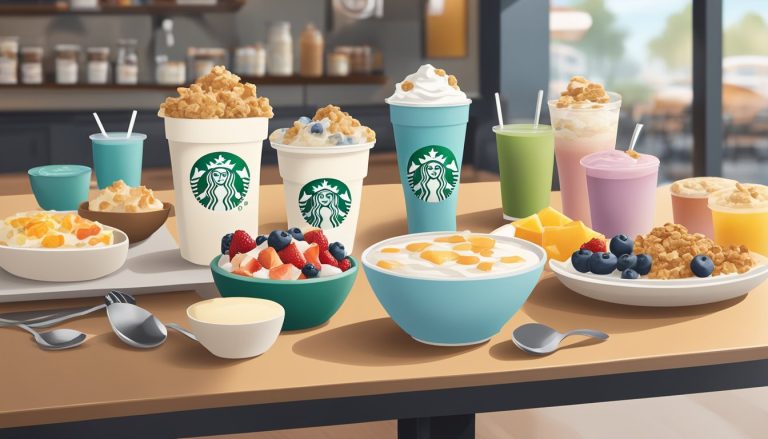Starbucks has made sustainability a core focus of its business operations, extending this commitment to its breakfast offerings. The company’s environmental promise to “give more than we take” from the planet shapes its approach to menu items, packaging, and sourcing practices.
Starbucks’ breakfast menu now features more plant-based options, reducing the carbon footprint associated with animal products. These choices align with the company’s goal to cut carbon emissions and appeal to environmentally conscious consumers. Additionally, Starbucks has introduced new cold cups made with up to 20% less plastic, which will keep over 13.5 million pounds of plastic out of landfills annually.
The coffee giant’s sustainability efforts also impact its sourcing of key breakfast ingredients. Starbucks continues to work towards ethically sourcing coffee and tea, supporting farmers and communities in the process. These initiatives aim to create a more sustainable and equitable future for the entire supply chain, from farm to cup.
Starbucks’ Commitment to Sustainability

Starbucks has made sustainability a core focus, setting ambitious goals to reduce its environmental impact while promoting equity and diversity. The company aims to become resource-positive and address climate change through various initiatives.
Environmental Promise and ESG Report
Starbucks pledges to give more than it takes from the planet. This commitment is outlined in their Environmental, Social, and Governance (ESG) Report. The company is working to reduce carbon emissions, water usage, and waste.
Starbucks is investing in regenerative agriculture and forest conservation. They’re also developing more eco-friendly stores and operations. A key initiative is the introduction of new cold cups made with up to 20% less plastic.
This change will keep over 13.5 million pounds of plastic out of landfills annually. Starbucks is also shifting away from single-use packaging towards reusable options.
Equity and Diversity Policies
Starbucks emphasizes inclusion, diversity, and belonging in its sustainability efforts. The company recognizes that environmental sustainability is closely linked to social equity.
They’re working to create opportunities for underrepresented communities in their supply chain. This includes supporting coffee farmers and investing in community development programs.
Starbucks aims to increase diversity within its workforce and leadership. They’ve implemented training programs to promote inclusivity and combat bias.
Sustainability Goals and Climate Change
Starbucks has set science-based targets to address climate change. They’re striving to become resource-positive, aspiring to store more carbon than they emit.
The company is expanding plant-based menu options to reduce its environmental footprint. They’re also investing in water replenishment projects in coffee-growing regions.
Starbucks is testing innovative solutions to support partners, farmers, and communities facing climate change impacts. They’re committed to building a more sustainable, equitable, and resilient future for coffee production.
Sustainable Sourcing Strategies
Starbucks implements comprehensive sustainable sourcing practices to ensure ethical procurement of coffee, tea, and other ingredients. The company focuses on supporting farmers, fostering industry partnerships, and maintaining transparency throughout its supply chain.
Ethical Sourcing of Coffee and Tea
Starbucks prioritizes ethical sourcing for its coffee and tea products. The company has achieved 98% ethically sourced and verified coffee. This commitment extends to their entire supply chain, from farm to cup.
Starbucks utilizes a set of social, economic, and environmental standards called Coffee and Farmer Equity (C.A.F.E.) Practices. These guidelines ensure fair wages, safe working conditions, and environmentally friendly farming methods.
For tea, Starbucks partners with suppliers who adhere to similar ethical standards. The company aims to source 100% of its tea from Rainforest Alliance Certified™ farms.
Supporting Coffee and Tea Farmers
Starbucks actively supports the farming communities that grow its coffee and tea. The company works with over 400,000 farmers globally, providing resources and training to improve crop quality and yield.
Key initiatives include:
- Farmer Support Centers: Nine global centers offering agronomic assistance
- Global Farmer Fund: $50 million investment to support coffee farmers
- Starbucks Reserve: Promoting small-lot, premium coffees from select farms
These programs help farmers increase their income and adopt sustainable farming practices. Starbucks also invests in eco-friendly technologies, such as water-saving wet mills, to reduce environmental impact.
Partnerships for a Sustainable Future
Starbucks collaborates with various organizations to drive sustainability in the coffee industry. These partnerships focus on improving farming practices, protecting the environment, and ensuring fair treatment of workers.
Notable collaborations include:
- Conservation International: Addressing climate change impacts on coffee-growing regions
- World Coffee Research: Developing climate-resilient coffee varieties
- Sustainable Coffee Challenge: Industry-wide initiative to make coffee the world’s first sustainable agricultural product
Starbucks also participates in multi-stakeholder forums to share best practices and promote transparency. The company regularly publishes sustainability reports detailing its progress and future goals.
Reducing Environmental Impact in Operations
Starbucks has implemented several initiatives to minimize its environmental footprint across its global operations. These efforts focus on store design, energy usage, and water conservation to create more sustainable coffee shops.
Greener Stores Initiative
The Greener Stores Initiative aims to reduce the environmental impact of Starbucks locations worldwide. Over 3,500 stores have earned the “Greener Store” designation as of 2022. These locations meet strict standards for energy efficiency, waste reduction, and water conservation.
Greener Stores use LED lighting, energy-efficient appliances, and recycled building materials. They also implement waste sorting systems to maximize recycling and composting. Some stores feature living walls or green roofs to improve air quality and reduce energy needs.
Investment in Renewable Energy and High-Efficiency Appliances
Starbucks has committed to powering its stores with 100% renewable energy. The company purchases renewable energy credits and invests in solar and wind projects across its markets.
In stores, Starbucks installs high-efficiency espresso machines, refrigerators, and ovens. These appliances use up to 30% less energy than standard models. Smart systems monitor and optimize energy usage throughout the day.
The company also tests innovative technologies like on-site solar panels and battery storage systems at select locations.
Water Use and Conservation Efforts
Water stewardship is a key focus of Starbucks’ sustainability efforts. The company aims to reduce water usage in stores by 50% by 2030. Water-saving measures include:
• Low-flow faucets and fixtures
• Efficient dishwashers that use 50% less water
• Drought-resistant landscaping at store locations
• Water reclamation systems in some stores
Starbucks also invests in watershed protection projects in coffee-growing regions. These efforts help preserve water resources for local communities and ecosystems.
Innovation in Waste Management and Resource Usage
Starbucks has implemented cutting-edge strategies to minimize waste and optimize resource usage in its operations. These efforts span circular economy principles, innovative recycling programs, and water conservation initiatives.
Circular Economy and Responsible Materials
Starbucks is investing $10 million in Circular Services to reduce landfill waste and drive innovative efforts towards a circular economy in the United States. The company is developing new cold cups made with up to 20% less plastic, which will keep over 13.5 million pounds of plastic from landfills annually.
Starbucks aims to become a resource-positive company by reimagining its product packaging and store equipment. They are exploring alternatives to single-use plastics and testing reusable cup programs in various markets.
The company has also introduced the Starbucks Circular Cup in EMEA regions, offering customers a 25p discount for each use.
Waste Diversion and Recycling Initiatives
Starbucks has set ambitious targets to cut its waste footprint in half by 2030. The company is innovating, testing, and learning from store partners to achieve these goals.
Key initiatives include:
- Unique promotions like the annual reusable red cup giveaway
- Partnering with Ocean Conservancy to encourage use of clean, reusable cups
- Implementing store-level recycling programs for coffee grounds and food waste
- Developing compostable and recyclable packaging solutions
Starbucks is also working to improve recycling infrastructure and educate customers on proper waste sorting practices.
Water Recycling and Usage Reduction
Water conservation is a crucial aspect of Starbucks’ sustainability efforts. The company is implementing innovative water recycling systems in its stores and roasting facilities.
Specific measures include:
- Installing water-efficient fixtures and equipment
- Implementing greywater recycling systems for landscaping and non-potable uses
- Optimizing cleaning processes to reduce water consumption
- Partnering with local communities to protect and restore water resources
Starbucks is also investing in research and development to create more water-efficient brewing methods and equipment, further reducing its environmental footprint in coffee production and service.
Infrastructure for Sustainable Consumption

Starbucks has implemented key infrastructure to support sustainable consumption in its stores. These initiatives aim to reduce waste, promote clean energy, and create more eco-friendly spaces for customers.
Availability of Reusable Cups
Starbucks offers reusable cup programs to minimize single-use waste. Customers can purchase durable, branded tumblers and mugs for repeated use. The company provides discounts for those who bring their own cups.
In some locations, Starbucks has tested cup rental systems. Customers borrow cups and return them to participating stores. This reduces disposable cup usage while maintaining convenience.
The company has set ambitious goals to increase reusable cup adoption. It aims for 25% of beverages to be served in reusable vessels by 2025. To support this, Starbucks is expanding cup washing facilities in stores.
Electric Vehicle Charging Stations
Select Starbucks locations now feature electric vehicle charging stations. This infrastructure supports customers transitioning to cleaner transportation options. EV drivers can charge their vehicles while enjoying their beverages.
The company has partnered with ChargePoint and other providers to install charging equipment. Fast-charging options are available at some stores, allowing for quick top-ups during short visits.
Starbucks plans to expand its EV charging network significantly. The goal is to have charging stations available every 100 miles along major U.S. highways by 2025.
Solar Panels and Green Building Design
Starbucks has integrated solar panels into many store designs. These systems generate clean energy to power operations. Some locations even feed excess electricity back into the local grid.
The company uses LEED certification standards for new store construction. This ensures buildings are energy-efficient and use sustainable materials. Features may include LED lighting, water-saving fixtures, and recycled building components.
Starbucks has committed to designing, building, and operating 10,000 “Greener Stores” globally by 2025. These locations will incorporate the latest in sustainable design and operations.
Global Efforts and Their Local Impact

Starbucks implements sustainability initiatives worldwide, adapting strategies to regional needs while maintaining a unified vision. These efforts span economic empowerment, environmental stewardship, and community engagement across diverse markets.
Starbucks in China: A Case Study
In China, Starbucks has made significant strides in sustainability. The company opened a Greener Store in Shanghai, showcasing eco-friendly design and operations. This store uses 30% less energy and water compared to traditional outlets. Starbucks also launched a reusable cup program in China, encouraging customers to reduce single-use waste.
The company partnered with local farmers to develop sustainable coffee growing practices. This initiative supports over 100,000 coffee farmers across Yunnan province. Starbucks provides training on water conservation techniques and soil management, improving crop yields and environmental protection.
Loans and Investments for Local Development
Starbucks offers loans and investments to support local communities globally. The company committed $100 million to the Community Resilience Fund, focusing on underdeveloped neighborhoods in the U.S.
In coffee-growing regions, Starbucks provides loans to farmers for equipment upgrades and sustainable farming practices. These loans have benefited over 40,000 farmers across Latin America, Africa, and Asia.
The company also invests in water stewardship projects. In Indonesia, Starbucks funded the construction of 1,000 water sanitation facilities, improving access to clean water for coffee-growing communities.
Inclusion and Community Engagement
Starbucks prioritizes inclusion and community engagement in its global operations. The company aims to hire 5,000 refugees across its European stores by 2022. In the U.S., Starbucks committed to opening 100 stores in underserved communities, creating local job opportunities.
The Starbucks Foundation’s Global Community Impact Grants program awarded over $10 million to nonprofits worldwide in 2023. These grants support youth empowerment, economic opportunity, and environmental action.
Starbucks also engages partners (employees) in community service. In 2023, partners contributed over 1 million volunteer hours globally, supporting local causes and environmental initiatives.




